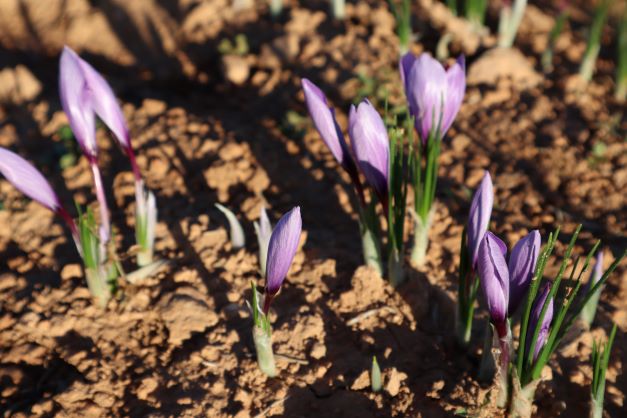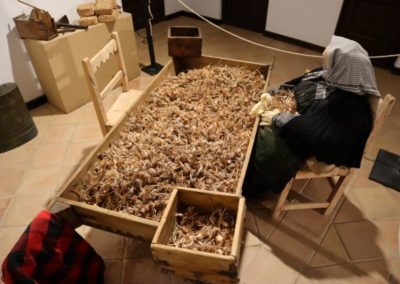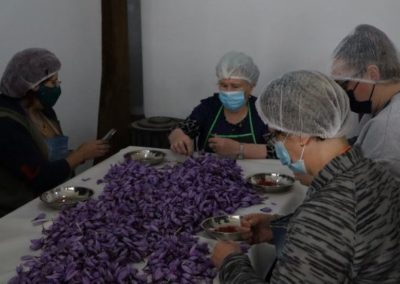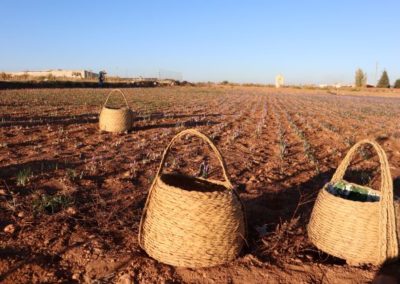Saffron from La Mancha
Inland and Coastal Countryside and Plains Model
Autores: Mª Carmen Cañizares and Ángel Raúl Ruiz Pulpón
Overview of SAMUTER
SAMUTER will analyse the interrelationships between the natural and human conditions of the territory where saffron crops are grown in the region of La Mancha, in the region of Castilla-La Mancha (Spain).
1. Environmental sustainability
Saffron cultivation is a secondary agricultural activity in a context dominated by the Mediterranean trilogy of vineyards, olive groves and cereals that characterises the region of Castile-La Mancha and, specifically, the district of La Mancha.
As in the case of vineyards, the environmental sustainability of the crop can be seen in the adaptation of saffron both to the physical and chemical conditions of the soil (preferably limestone) and to the climatic rigours of the inland Mediterranean climate, marked by temperature and rainfall irregularities; where, despite being a minority crop, it is resistant to drought and helps to halt desertification. It only presents problems in waterlogged areas, which are unlikely in the region. Their authenticity should also be noted in relation to common geographical values related mainly to vegetation, soils and climate.
2. Territoriality and agri-environmental policies
Castilla-La Mancha is clearly dominant in terms of the surface area dedicated to this crop and production figures within Spain, as it cultivates around 77% of the total surface area (157 ha) and produces 85% (1,315 kg), according to the information provided by the MAPA for 2021, followed by regions such as Catalonia and Andalusia.
Although it is a minority crop that occupies a small area, its increase has been constant in recent years (with the exception of the health crisis period), both in dry farming and, above all, in irrigated farming, due to the high profitability of a product that is essentially used as a condiment.
In the region of Castilla-La Mancha it is located in the central area, with an important role played by the region of La Mancha, where natural conditions are more favourable. By provinces there are sharp contrasts: Albacete practically has half of the arable land, with more than 70% irrigated, mainly in the area of Albacete and its surroundings (Chinchilla, Tobarra, Balazote, Lezuza); Cuenca and Toledo account for around 20% of the regional surface area, with Motilla del Palancar standing out in the first case, and the municipalities of Consuegra, Madridejos and Villafranca de los Caballeros in the second; Ciudad Real, for its part, is the province with the smallest presence of the crop, only 5% of the region, mainly concentrated in the towns of Membrilla and La Solana.
Its territorial character is also linked to adaptation to the geographical environment, which is manifested in the qualities of the final product, together with a markedly family farming model where certain common patterns are reproduced: small-sized plots; high added value of manual labour, especially of the female type; scarcely technified; and understood as a complementary or non-main crop.
3. Relations between production, processing, marketing and consumption
Despite the importance of the saffron groves in Castilla-La Mancha in terms of area and surface area compared to the national totals, their significance in the regional agricultural structure is barely token. As we have already mentioned, it is grown on small plots on quality land with deep, permeable, clayey soils close to population centres on small family farms that are almost self-sufficient in the preparation of the arable land, as well as in harvesting, pruning and roasting. All this in a context in which the cultivation of saffron fits in very well with the times of cereals, not hindering the need for labour for the latter, within an agricultural system of dominant crops in La Mancha in which saffron has traditionally been of special economic and social utility as a complementary activity.
A traditional sector that has adapted to the times and to the markets in order to be able to survive in a complex, globalised and highly competitive rural environment, in direct competition with Iranian, Greek and Italian saffron. From the point of view of regional production and processing, the Protected Designation of Origin Azafrán de La Mancha, which covers the provinces of Cuenca, Albacete, Toledo and Ciudad Real, stands out, as well as the Consejo Regulador Azafrán de La Mancha (La Mancha Saffron Regulatory Council) whose functions focus on the registration of plantations and the control of growers and packers to certify the labelling of the product, following a detailed process of respecting the harvesting cycle, the flower’s plucking and the roasting of the stigmas which, finally, are sold (roasted, not ground).
4. Good governance
Good governance in relation to saffron cultivation is centred on the maintenance of modest areas and production, whose cultural character is unquestionable, as well as on a well-structured family production network. A direct relationship with the identity of the people who live in the territory where the crop is grown, where the intangible heritage is very relevant (events and festivals, mainly). It is also worth mentioning the contribution to good governance formulas of the protection and safeguarding figures described above, especially the PDO Azafrán de La Mancha, together with other initiatives arising from the local administration that are dedicated to promotion and agricultural valorisation. One example of these actions was the opening, in 2008, of the Saffron and Ethnographic Museum in the municipality of Madridejos, which contains a wide range of material goods linked to the work of this agricultural activity.





Recent Comments